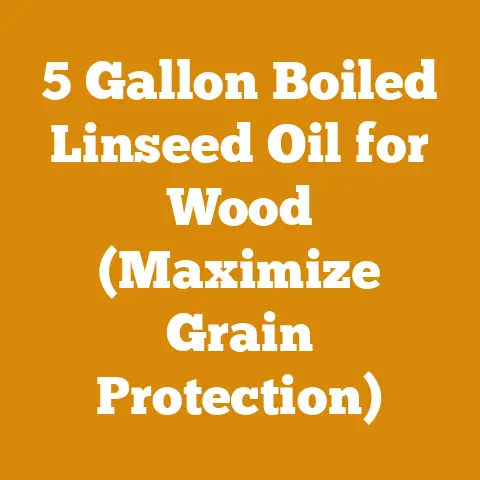When to Fertilize Arborvitae Green Giant (7 Pro Tips for Tree Care)
Do you ever find yourself looking out at your yard, dreaming of lush greenery, privacy, and a vibrant landscape that makes your neighbors envious? Or perhaps you’re already enjoying the beauty of Arborvitae Green Giants but want to ensure they stay healthy and thriving? If so, you’re in the right place!
I’ve spent years working with trees, from felling giants in the backwoods to meticulously caring for ornamentals in suburban gardens. There’s a special satisfaction in nurturing a tree, watching it grow, and knowing you’ve played a part in its health and longevity.
Key Takeaways You’ll Learn:
- The Importance of Soil Testing: Why a soil test is your first and most crucial step before applying any fertilizer.
- Optimal Timing for Fertilization: Understanding the best times of year to feed your Green Giants for maximum growth and health.
- Choosing the Right Fertilizer: Deciphering fertilizer labels and selecting the best formulation for Arborvitae.
- Application Techniques: Mastering the proper methods for applying fertilizer to ensure effective nutrient uptake.
- Recognizing Nutrient Deficiencies: Identifying common signs that your trees need a boost.
- Organic vs. Synthetic Fertilizers: Weighing the pros and cons of each option for your specific needs.
- Avoiding Over-Fertilization: Preventing common mistakes that can harm your trees.
So, grab a cup of coffee, settle in, and let’s dive into the world of Arborvitae Green Giant fertilization!
When to Fertilize Arborvitae Green Giant: 7 Pro Tips for Tree Care
The Foundation: Understanding Your Soil
Before even thinking about fertilizer, I always start with the soil. It’s the foundation of everything. Imagine trying to build a house on shifting sand – it won’t work. Similarly, you can’t expect your Arborvitae to thrive in poor soil, no matter how much fertilizer you throw at it.
The Power of a Soil Test
I cannot stress this enough: get a soil test! It’s the single most important thing you can do before fertilizing. A soil test tells you:
- pH Level: Arborvitae prefer slightly acidic soil (pH 6.0-7.0). If your soil is too alkaline or acidic, the trees won’t be able to absorb nutrients properly, even if they’re present.
- Nutrient Levels: The test will reveal which nutrients are deficient (e.g., nitrogen, phosphorus, potassium) and which are already abundant. This prevents you from wasting money on unnecessary fertilizers and, more importantly, avoids over-fertilization.
- Organic Matter Content: Soil rich in organic matter retains moisture and nutrients better, creating a healthier environment for root growth.
My Experience: I once had a client who insisted their Arborvitae were struggling because they weren’t getting enough fertilizer. They’d been applying a general-purpose fertilizer every spring for years. A soil test revealed that their soil was already overloaded with phosphorus and potassium, but severely deficient in nitrogen. The problem wasn’t a lack of nutrients, but an imbalance caused by blindly applying fertilizer.
Where to Get a Soil Test:
- Local County Extension Office: This is often the most affordable option. They can provide you with a soil test kit and instructions.
- Private Soil Testing Labs: These labs often offer more detailed analysis and recommendations.
- Home Soil Test Kits: While convenient, these kits are generally less accurate than professional tests.
Data Point: According to a study by the University of Minnesota Extension, approximately 70% of homeowners who fertilize their lawns and gardens do so without conducting a soil test, leading to potential over-fertilization and environmental damage.
Actionable Tip: Contact your local county extension office today to inquire about soil testing services.
Timing is Everything: When to Fertilize for Optimal Growth
Now that you understand the importance of soil testing, let’s talk about timing. When you fertilize your Arborvitae Green Giants can significantly impact their health and growth.
The Two Key Windows:
- Early Spring (Late March – Early April): This is the ideal time to give your trees a boost as they emerge from dormancy. The soil is warming up, and the trees are actively preparing for new growth.
- Late Fall (Late October – Early November): Fertilizing in the fall allows the trees to absorb nutrients before winter, strengthening their roots and improving their resilience to cold weather stress.
Why These Times Work:
- Spring: This is when Arborvitae are actively growing. They need readily available nutrients to support new foliage and root development.
- Fall: While top growth slows down in the fall, root growth continues. Fertilizing at this time allows the trees to store nutrients for the following spring’s growth spurt.
Avoiding Summer Fertilization:
I generally advise against fertilizing Arborvitae during the heat of summer. The trees are already stressed by the high temperatures and may not be able to effectively absorb the fertilizer. Furthermore, excessive fertilization in the summer can lead to rapid, weak growth that is more susceptible to pests and diseases.
Personal Story: I once made the mistake of fertilizing a client’s Arborvitae hedge in July, thinking I was doing them a favor. Within a few weeks, the trees were covered in spider mites and showing signs of stress. I learned my lesson the hard way – timing is crucial!
Data Point: Research from the International Society of Arboriculture (ISA) indicates that fall fertilization promotes root growth and improves the overall health and vigor of trees, leading to increased resistance to pests and diseases.
Actionable Tip: Mark your calendar for early spring and late fall to remind yourself to fertilize your Arborvitae.
Choosing the Right Food: Selecting the Best Fertilizer
Not all fertilizers are created equal. Understanding fertilizer labels and choosing the right formulation is essential for healthy Arborvitae growth.
Understanding N-P-K:
Fertilizer labels display three numbers, representing the percentage of nitrogen (N), phosphorus (P), and potassium (K) in the fertilizer. These are the three macronutrients that plants need in the largest quantities.
- Nitrogen (N): Promotes leafy green growth.
- Phosphorus (P): Supports root development and flowering (though Arborvitae don’t flower significantly).
- Potassium (K): Enhances overall plant health, disease resistance, and cold hardiness.
The Ideal N-P-K Ratio for Arborvitae:
For Arborvitae Green Giants, I recommend a fertilizer with a balanced or slightly nitrogen-heavy ratio. A good option is a 10-8-6 or 12-6-4 fertilizer. The higher nitrogen content will promote healthy green growth, while the phosphorus and potassium will support root development and overall health.
Slow-Release vs. Quick-Release Fertilizers:
- Slow-Release Fertilizers: These fertilizers release nutrients gradually over several months. They are generally safer and more effective for Arborvitae, as they provide a consistent supply of nutrients without the risk of burning the roots.
- Quick-Release Fertilizers: These fertilizers release nutrients rapidly, providing a quick boost to growth. However, they can also be more likely to burn the roots if applied improperly.
My Preference: I almost always use slow-release fertilizers for Arborvitae. They’re more forgiving and provide a more sustainable source of nutrients.
Organic vs. Synthetic Fertilizers:
- Organic Fertilizers: These fertilizers are derived from natural sources, such as compost, manure, and bone meal. They release nutrients slowly and also improve soil health.
- Synthetic Fertilizers: These fertilizers are manufactured chemically and provide a concentrated dose of nutrients. They can be more effective in correcting nutrient deficiencies, but they don’t improve soil health and can be harmful if over-applied.
My Approach: I often use a combination of organic and synthetic fertilizers. I might use a slow-release organic fertilizer as a base and supplement with a small amount of synthetic fertilizer to address specific nutrient deficiencies.
Data Point: A study published in the Journal of Environmental Quality found that slow-release fertilizers resulted in more consistent growth and reduced nutrient leaching compared to quick-release fertilizers.
Actionable Tip: Head to your local garden center and look for a slow-release fertilizer with a balanced or slightly nitrogen-heavy N-P-K ratio.
Applying the Food: Techniques for Effective Fertilization
Knowing when and what to fertilize with is only half the battle. You also need to know how to apply the fertilizer properly.
The Drip Line Method:
The most effective way to fertilize Arborvitae is to apply the fertilizer around the drip line of the tree. The drip line is the area directly beneath the outermost branches. This is where the majority of the tree’s feeder roots are located.
How to Apply:
- Measure the Drip Line: Estimate the diameter of the drip line by measuring the distance from one side of the tree to the other, at the widest point.
- Calculate the Fertilizer Amount: Follow the instructions on the fertilizer label to determine the correct amount of fertilizer to apply per square foot of the drip line area.
- Spread the Fertilizer Evenly: Use a spreader or your hands (with gloves!) to evenly distribute the fertilizer around the drip line.
- Water Thoroughly: After applying the fertilizer, water the area thoroughly to help dissolve the fertilizer and move the nutrients into the soil.
Avoiding Trunk Contact:
Never apply fertilizer directly against the trunk of the tree. This can damage the bark and lead to disease.
Foliar Feeding (Optional):
Foliar feeding involves spraying a diluted fertilizer solution directly onto the foliage of the tree. This can be a quick way to address nutrient deficiencies, but it’s not as effective as soil application for long-term fertilization.
My Experience: I sometimes use foliar feeding to give Arborvitae a quick boost after transplanting or during periods of stress. However, I always use a very diluted solution to avoid burning the foliage.
Data Point: Research from Purdue University Extension indicates that foliar feeding can be an effective way to deliver micronutrients to plants, but it should not be used as a primary method of fertilization.
Actionable Tip: Practice the drip line method when fertilizing your Arborvitae.
Reading the Leaves: Recognizing Nutrient Deficiencies
Even with proper fertilization, your Arborvitae may still exhibit signs of nutrient deficiencies. Learning to recognize these signs can help you address the problem quickly and effectively.
Common Nutrient Deficiencies and Their Symptoms:
- Nitrogen Deficiency: Yellowing of the older, lower leaves.
- Phosphorus Deficiency: Stunted growth and purplish discoloration of the leaves.
- Potassium Deficiency: Yellowing or browning of the leaf margins.
- Magnesium Deficiency: Yellowing between the veins of the older leaves.
- Iron Deficiency: Yellowing between the veins of the younger leaves (chlorosis).
Diagnosing the Problem:
If you suspect a nutrient deficiency, start by examining the leaves closely. Note the color, pattern, and location of the symptoms. Compare your observations to the descriptions above to identify the likely deficiency.
Confirming with a Soil Test:
While visual symptoms can be helpful, it’s always best to confirm your diagnosis with a soil test. This will provide you with accurate information about the nutrient levels in your soil and help you choose the right fertilizer to correct the deficiency.
Addressing the Deficiency:
Once you’ve identified the deficiency, you can address it by applying a fertilizer that is rich in the missing nutrient. For example, if your Arborvitae is showing signs of nitrogen deficiency, you can apply a fertilizer with a high nitrogen content.
My Observation: Iron deficiency (chlorosis) is a common problem in Arborvitae grown in alkaline soils. In these cases, I recommend applying chelated iron to the soil or as a foliar spray.
Data Point: A study by the University of California Cooperative Extension found that visual diagnosis of nutrient deficiencies can be unreliable, and soil testing is essential for accurate identification and treatment.
Actionable Tip: Regularly inspect your Arborvitae for signs of nutrient deficiencies.
Organic vs. Synthetic: Choosing the Right Approach
As mentioned earlier, you have the option of using organic or synthetic fertilizers. Each approach has its own advantages and disadvantages.
Organic Fertilizers: The Natural Approach
- Pros:
- Improve soil health by adding organic matter.
- Release nutrients slowly and steadily.
- Less likely to burn the roots.
- Environmentally friendly.
- Cons:
- May be more expensive than synthetic fertilizers.
- Nutrient content may be less precise.
- May take longer to see results.
Examples of Organic Fertilizers:
- Compost
- Manure
- Bone Meal
- Blood Meal
- Fish Emulsion
Synthetic Fertilizers: The Targeted Approach
- Pros:
- Provide a concentrated dose of nutrients.
- Can be more effective in correcting nutrient deficiencies.
- Generally less expensive than organic fertilizers.
- Cons:
- Don’t improve soil health.
- Can burn the roots if over-applied.
- Can leach into the environment and pollute waterways.
My Recommendation:
I believe that a balanced approach is often the best. I like to use organic fertilizers as a base to improve soil health and provide a slow-release source of nutrients. Then, I supplement with synthetic fertilizers as needed to address specific nutrient deficiencies.
Case Study: A local nursery owner I know swears by using compost tea as a regular soil drench for his Arborvitae. He claims it significantly improves their overall health and vigor.
Actionable Tip: Experiment with both organic and synthetic fertilizers to see what works best for your Arborvitae and your soil conditions.
Avoiding Over-Fertilization: The Dangers of Too Much Love
While fertilization is important, it’s also possible to overdo it. Over-fertilization can be just as harmful as nutrient deficiencies.
Signs of Over-Fertilization:
- Burned Leaf Margins: The tips and edges of the leaves may turn brown and crispy.
- Salt Buildup on the Soil Surface: You may see a white or crusty residue on the soil surface.
- Stunted Growth: Ironically, over-fertilization can actually stunt growth.
- Increased Susceptibility to Pests and Diseases: Over-fertilized plants are often more attractive to pests and more susceptible to diseases.
Why Over-Fertilization is Harmful:
Over-fertilization can disrupt the delicate balance of nutrients in the soil, leading to nutrient imbalances and toxicity. It can also damage the roots of the tree, making it difficult for it to absorb water and nutrients.
Preventing Over-Fertilization:
- Always Follow the Instructions on the Fertilizer Label: Don’t be tempted to apply more fertilizer than recommended.
- Conduct a Soil Test Before Fertilizing: This will help you determine if your soil actually needs fertilizer.
- Use Slow-Release Fertilizers: These fertilizers are less likely to cause over-fertilization.
- Water Thoroughly After Fertilizing: This will help to dissolve the fertilizer and move the nutrients into the soil.
My Biggest Mistake: I once over-fertilized a client’s prized Japanese maple, thinking I was giving it a boost before a garden tour. The tree ended up with severe leaf burn and took months to recover. It was a painful lesson in the importance of moderation.
Data Point: Research from the EPA indicates that over-fertilization is a major contributor to water pollution, as excess nutrients can runoff into waterways and cause algal blooms.
Conclusion: Nurturing Your Green Giants to Thrive
Fertilizing your Arborvitae Green Giants is an investment in their health and beauty. By understanding the importance of soil testing, timing, fertilizer selection, and application techniques, you can ensure that your trees receive the nutrients they need to thrive.
Final Thoughts:
- Start with a Soil Test: It’s the foundation of successful fertilization.
- Time Your Fertilization Wisely: Early spring and late fall are the optimal times.
- Choose the Right Fertilizer: A balanced or slightly nitrogen-heavy slow-release fertilizer is best.
- Apply Fertilizer Properly: Use the drip line method and avoid trunk contact.
- Monitor Your Trees for Nutrient Deficiencies: Learn to recognize the signs and address them promptly.
- Don’t Over-Fertilize: More is not always better.
Call to Action:
Take the first step towards healthier Arborvitae today! Schedule a soil test, research the best fertilizers for your soil conditions, and mark your calendar for your next fertilization. Your Green Giants will thank you for it! And who knows, maybe you’ll even inspire your neighbors to follow suit, creating a community of thriving landscapes.






